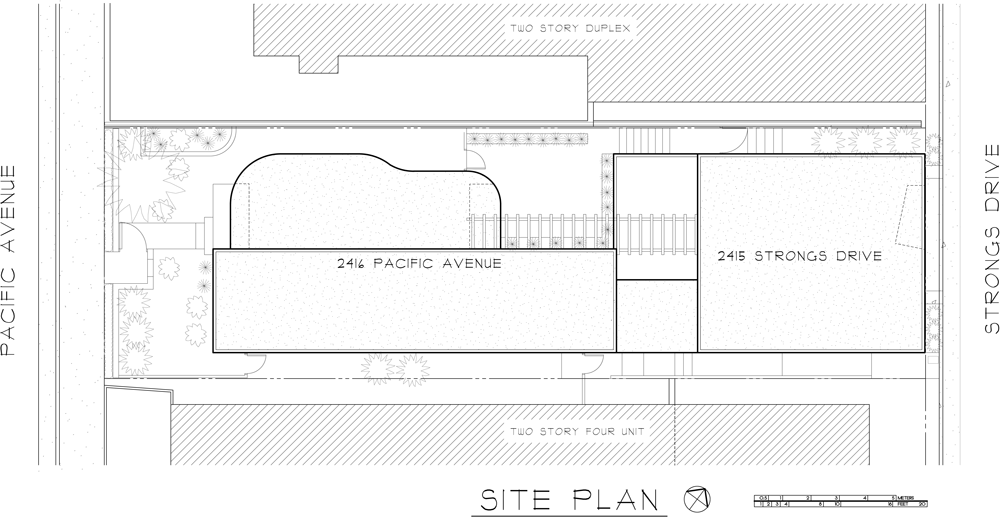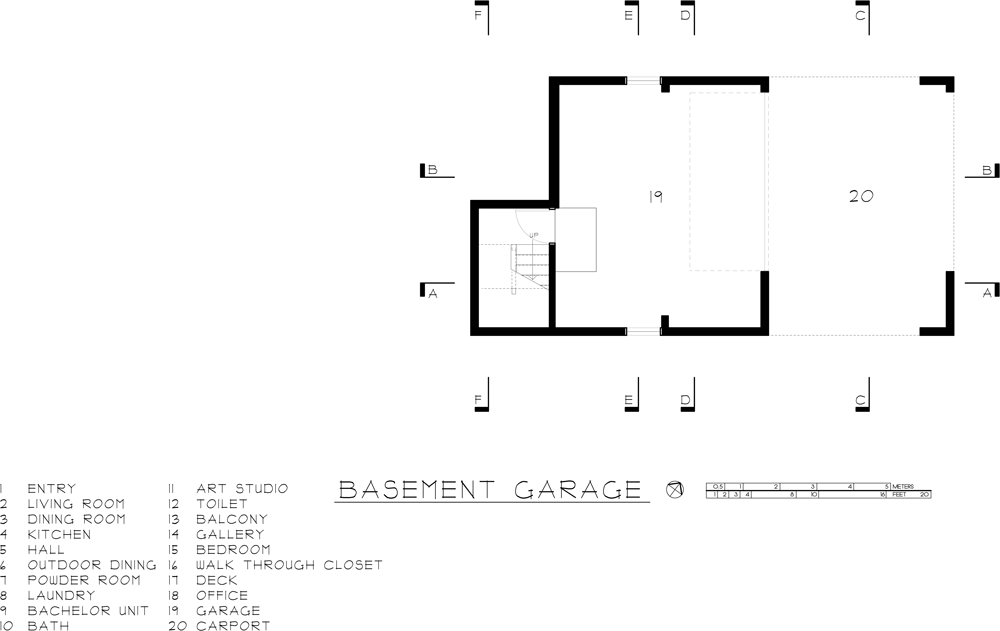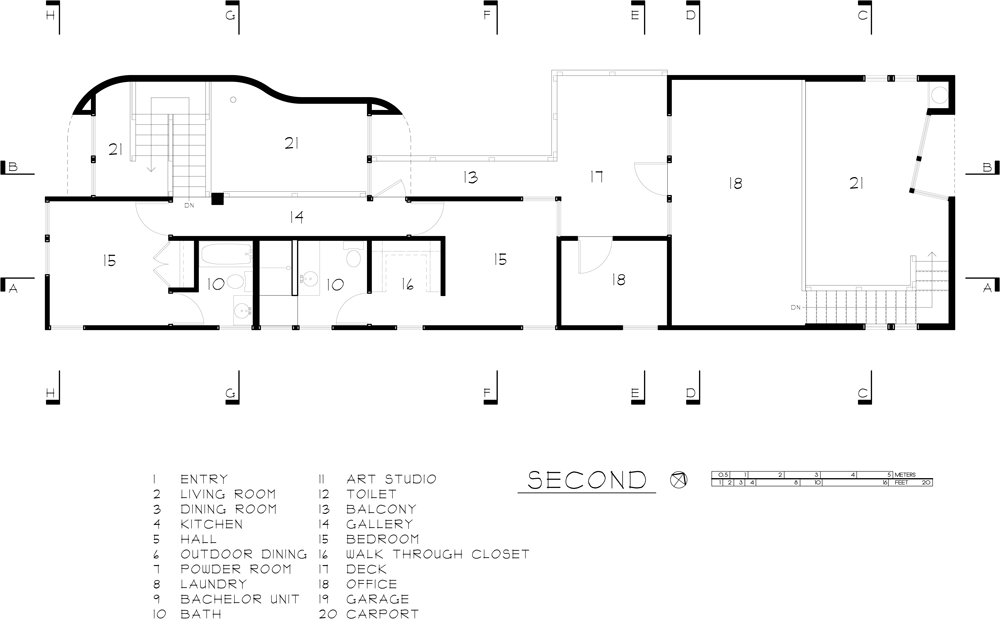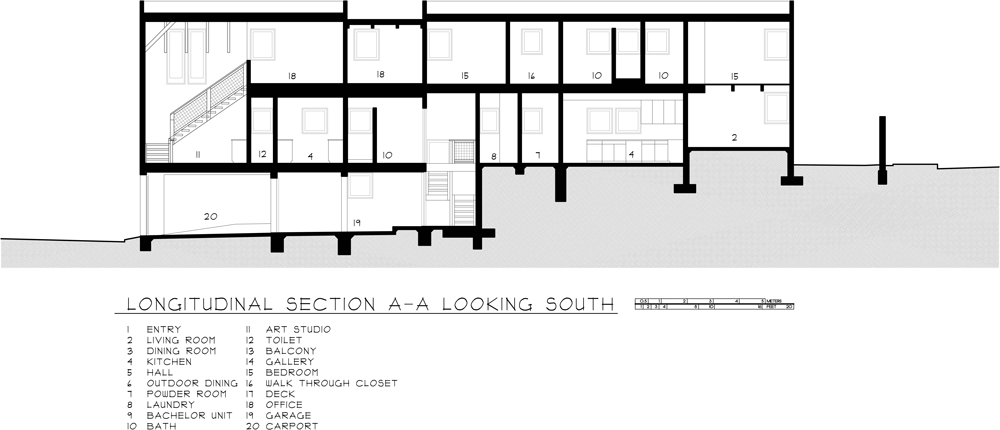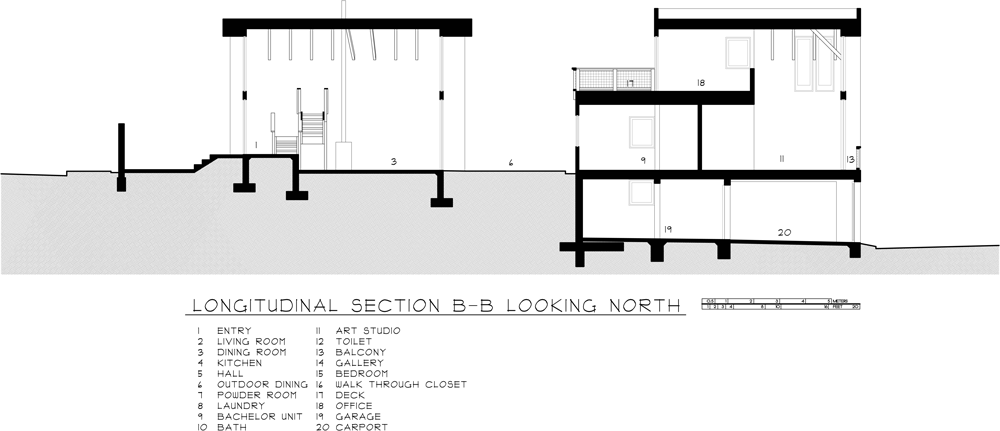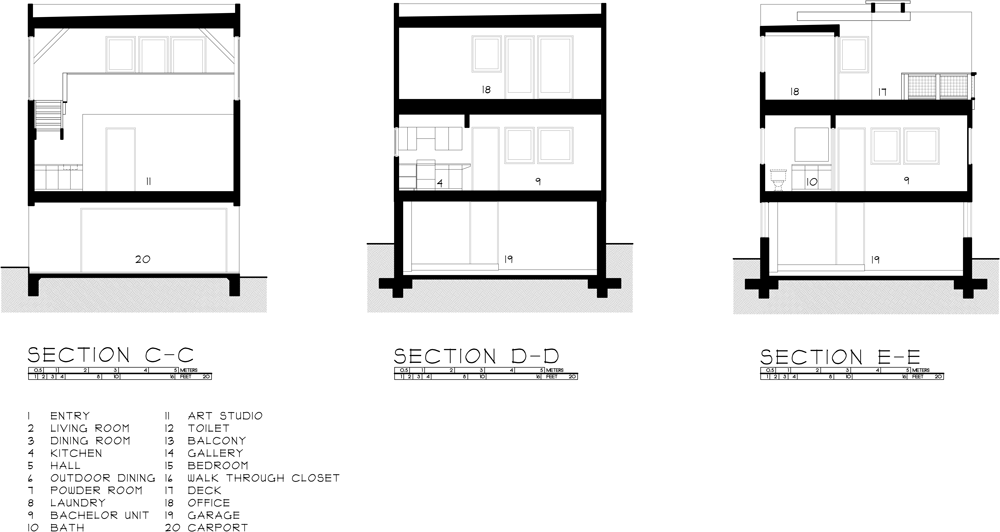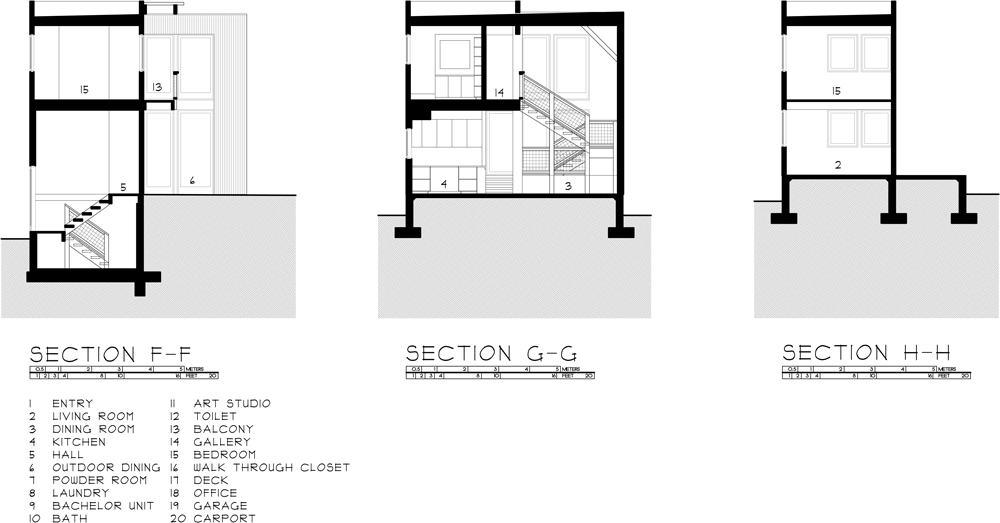Williams Family Guitar House, Venice, California
designed 1996, construction completed 2000-2004
The Guitar House takes its name from its massing and volumetric composition inspired by the work of Pablo Picasso during the 1910s when an idée fix caused the subject of nearly every work of art he produced to center on a reference to a stringed musical instrument. The project was conceived as a new single family dwelling on a vacant infill through lot at the gritty urban beach with the intent of converting it into a duplex at some unspecified future date with a minimum of physical intervention. As such the single family dwelling was completed in 2000. Following lengthy and arduous approval processes the duplex conversion was completed in 2004. The program consists of a dwelling unit for the husband and wife owners and their small child, including two home offices, and an SRO-like dwelling unit for a younger brother disabled with schizophrenia for a total area of 2,400 square feet plus an attached two car basement garage. Some of the numerous goals sought from the project’s inception include: a necessarily low initial construction cost; therefore, ease of construction by inexpert and sometimes psychotic hands; a calm home setting; excellent architectural design.
The sustainability goals achieved by the Guitar House include minimizing the use of nonrenewable energy sources; harvesting solar energy through the use of 28 rack mounted photovoltaic panels on the roof; maximizing the use of passive solar heating; maximizing the use of the copious and nearly constant natural ventilation and cooling that the close proximity to the Pacific Ocean provides; the use of ample and well distributed fenestration that obviates artificial illumination during daylight hours; the extensive use of sustainable building materials; a rigorously studied and judicious use, reuse and recycling of materials, keeping waste to a minimum; minimizing embodied energy in the construction process; and effecting an indoor air quality appropriate for occupants with allergies and Multiple Chemical Sensitivities. Rather than using a single bullet to achieve each of these goals a holistic approach was taken centered on an overarching philosophy with overlapping effects and multivalent purposes in the decision making and design processes that resulted in an integrated solution. Aesthetics and the experiential art that architecture is remained constants throughout the design and construction processes.
The building site, purchased by the current owner in a vacant state in 1996, was previously occupied by a decrepit surf shack that was home to Jay Adams, a subject of the 2001 documentary “Dogtown and Z-Boys” as well as one of the protagonists of the 2005 biopic “Lords of Dogtown”. In 1988 the termite infested shack blew down during a storm and was subsequently condemned by the building department until it was demolished. The lot remained vacant until the current owner commenced construction in 1998. In that 10 year interim the site returned to its former state as the last sand dune east of the beach with native vegetation repopulating the beach sand. Fittingly, neighborhood dogs roamed the lot until excavations for the construction commenced. Portions of the native ice plant were preserved and replanted during the landscaping phase following the completion of construction. Though the lot is very small most of the remaining yard areas were preserved as permeable beach sand and minimally landscaped with native xeriscape species and hardscaped with rocks and loose laid pavers. A cherry wood veneer plywood surfboard shaped coffee table in the living room pays homage to the shack in which the former owner repaired and built surfboards.
A scale model of the project was used in the early stages of the design phase and placed in its eventual orientation for observation throughout the days and seasons. Shading devices were incorporated to reduce heat gain during the summer but allow solar energy to be harvested during the winter by storing the collected energy in a thick concrete slab thus minimizing the requirements for active mechanical heating and cooling systems. The use of numerous operable fenestration units configured in relation to the predictable ocean breezes provides ample natural ventilation. Consequently, the project has no active ventilation or cooling systems and uses two small gas fired gravity furnaces in two separate zones and one gas fired furnace with an integrated fan in a third zone to augment the passive solar heating. Additionally, the large number of sun days enjoyed in Southern California made the use of a photovoltaic system a natural fit.
The study of the seasons and weather cycles throughout the design process resulted in both a shallow “U” shaped mass and a side-stepped mass at the front with an overhang to regulate the degree of exposure to the sun. The massing effort provided a courtyard that increased the surface area of the thermal envelope for fenestration and opened the rear unit to access more of the available light, air and views.
This courtyard, in conjunction with a similar courtyard mirrored across the adjoining property boundary line with the neighboring existing duplex to the north, offered a distance between the two buildings of approximately thirty feet rather than the usual six foot distances resulting from adjoining three foot side yard setbacks. These measures resulted in the ability to configure ample access to passive solar energy, light, air and views for both dwelling units and home offices in the project. Every room in the project, including the laundry room and the garage, has direct access to natural daylight, natural ventilation and views.
The design of the project strives to integrate numerous energy sources and conservation strategies while optimizing the use of renewable energy sources and minimizing contributory pollution inasmuch as possible as evidenced by the extensive and holistic use of harvested daylight, passive solar heating, natural ventilation, natural passive cooling and crystalline silicone solar photovoltaic arrays. The photovoltaic arrays are roof top mounted to optimize the exposure to solar energy for conversion to AC power in a net metering scheme. Excess energy produced at peak daylighting is directed back into the grid where energy loss due to transmission is minimized by consumption by the nearest adjacent power consumer – our immediate neighbors. Harvesting passive solar energy through insolation stored in a thickened concrete floor slab minimized the reliance upon the three zone gas fired furnace scheme. Ample operable fenestration maximizes the use of natural daylighting and optimizes the natural cooling and ventilation of the cool ocean breezes. Though simply listing these attributes doesn’t fully explain the synergy achieved by the careful integration of all of these various elements so that, for example, the combination of convection from solar gain in transitional spaces augments the function of passive ventilation and thus cooling.
The most important material selection criteria employed throughout required striking a balance between what was green and what was clean. Again a holistic approach that resulted in an integrated solution observed an overarching philosophy in the decisions made about materials. Building trades and suppliers were selected roughly from the same telephone area code as the project to reduce commuting and transportation. While a best attempt was made to balance cut and fill on the site, when spoil that had been cut had to be exported a receiving site requiring spoil was found less than 2 miles away thus minimizing embodied energy and carbon. The materials selected for the exterior siding – mineral fiber cement board and corrugated sheet metal siding – feature a long service life as well as the ability to be removed and reused, rather than merely recycled, on or off site. The lumber used for concrete forms was reused over the course of eleven separate pours and then used in the structure and on other jobsites when and where possible. Waste materials were kept to a minimum through constantly judicious reuse and then sent off for recycling when reuse was no longer possible.
The Guitar House is both an experiment and a demonstration that a delightful, hand made, sustainable, architecturally designed residence can be constructed on an uncommonly low budget.
Photography: Keith Baker
- contemporary design
- green building design
- infill housing
- low cost
- sustainable
